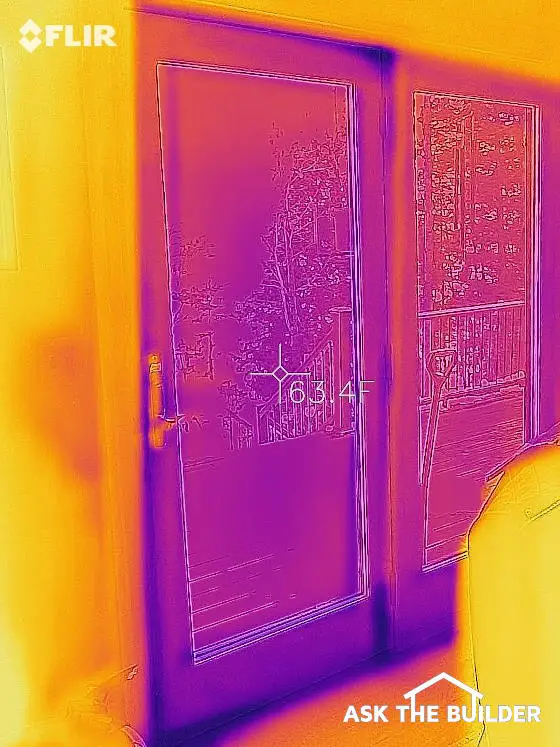Use an Infrared and Other Cameras to Spot Problems

This is an infrared photo of an exterior door at my own home. You can clearly see small air leaks (darker blue spots) where cold air is leaking around the weatherstripping. (C) Copyright 2020 Tim Carter
DEAR TIM: I’ve seen odd-looking photos taken with infrared (IR) cameras. They seem to me to be more of a novelty than a useful tool. Do you own one and how do you use it to help you around your home? What was the most shocking thing you discovered while using an infrared camera? Can you get one that attaches to a smartphone? Do you have a collection of photos you can share? Mandy P., Montgomery, AL
I don’t know about you, but I love questions like the ones Mandy poses. Just a few weeks ago, I started a new series where I wanted to share with you how advances in technology in all aspects of residential construction are helping you, but sometimes hurting you.
This week, I’m happy to announce that an affiliated area of technology, photography, has made vast improvements to help you spot all sorts of problems around your home. Let’s get started.
I was very interested in photography in high school and college decades ago. It’s important to realize I had my own darkroom and I helped run the largest darkroom on the University of Cincinnati campus. Yes, those were the days of real film and black and white photos were still quite the rage - believe it or not.
Before I share all the good news and the ways that infrared cameras can help you, let me just briefly touch on digital photography. You and I now live in the world of pixels instead of the days of small silver salts on cellulose acetate film! Each year new technology is making digital photography far better than the best old-fashioned large-format photos. There’s not a doubt in my mind that our digital spy satellites high in the sky have such advanced technology they can read the print of the open book in your hands while you’re out on your deck. But I digress.
Because you don’t have to pay for film or get it developed, you should take advantage of this to take hundreds, or thousands, of digital photographs of any project you’re doing. Take multiple photos of each step.
Why? Every week I do phone consults where people have huge problems with their homes. Each time I get to see detailed photos of the job in progress, I can see exactly why they have the problem. The clarity and high resolution of modern smartphone cameras is remarkable. I can zoom in and see very small details.
Keep in mind that you can store thousands of photos online for free. Depending what service you use, your photos automatically get transferred off your phone and stored on secure cloud servers. It’s a painless process you should be doing with all your photos.
Let’s switch to infrared, the subject Mandy wants to know about. I’ve been taking infrared photos for about five years and love this technology. You can buy dedicated infrared cameras just like a normal point-and-shoot camera, or you can buy a sleek tiny infrared camera that plugs into the charging slot of your smartphone. I have a smartphone infrared camera.
I’ve used my infrared camera to take all sorts of interesting photos. I discovered exactly why I got second-degree burns on my hands while installing my new roof five years ago. The synthetic-slate shingles I used heat up to about 160 degrees F in the mid-day sun! If you don’t work fast and keep moving with fresh shingles, you can get a burn in just two seconds or less touching a hot shingle!
I didn’t build the house I live in right now and I’ve used my IR camera to discover where the builder and his subs did a less-than-satisfactory job of installing insulation. The infrared camera shows you in just an instant where insulation is compacted or missing. It shows up as dark blue or violet on my camera.
I’ve also used it to locate air leaks in interior walls of all places! Down in my basement, I have an electrical outlet on an interior wall that leaks cold air. I noticed this by accident by scanning this wall with my infrared camera! No doubt the insulating contractor didn’t squirt expanding foam in the holes the electric cable passes through on the wall studs or the top wall plate.
You can also use an infrared camera to spot dangerous electrical arcing in your home. Electrical arcing that’s not yet started a fire will heat up where the arcing is occurring whether it be a screw on an outlet or switch, a lose connection at a circuit breaker in your panel, or even loose wires inside a wire nut. Purchasing an infrared camera for just this purpose may more than pay for itself in your peace of mind.
You can also use an infrared camera to help you spot possible water leaks that you don’t yet see in your home. Wet areas from hidden condensation or just damp areas behind walls or ceilings often show up on the camera as blue or violet because evaporating water by its very nature creates a cooling effect.
I do have a collection of infrared photos on my AsktheBuilder.com website as you might expect. All you have to do is type: “infrared photos” into the search engine there to view them.
Column 1338